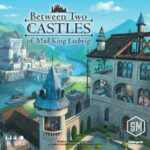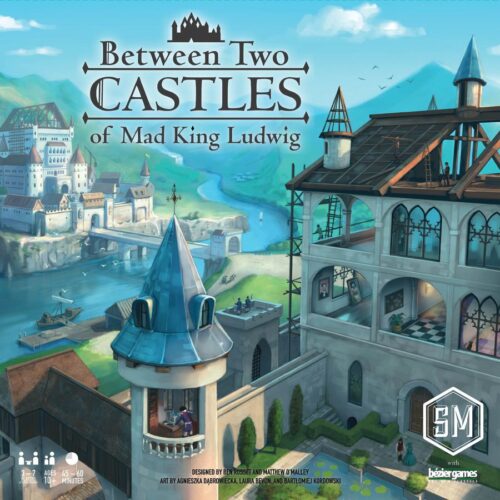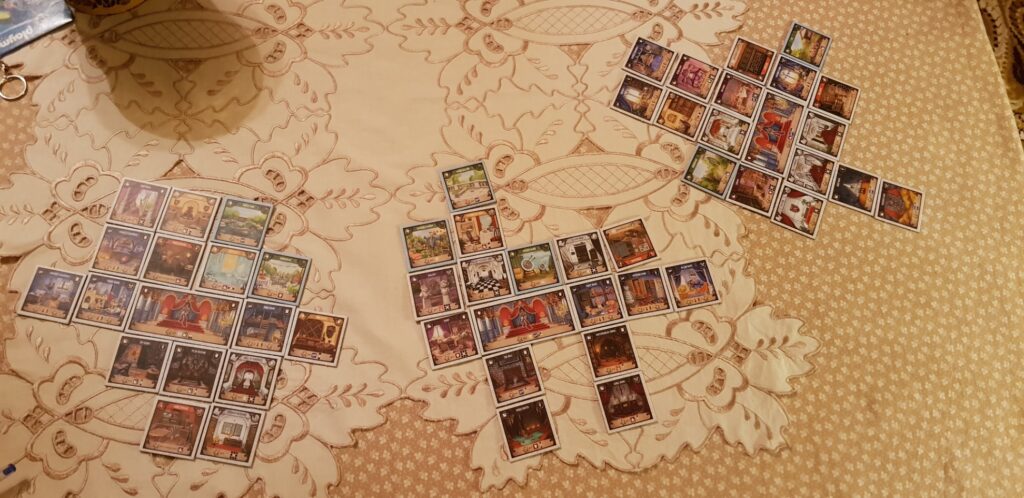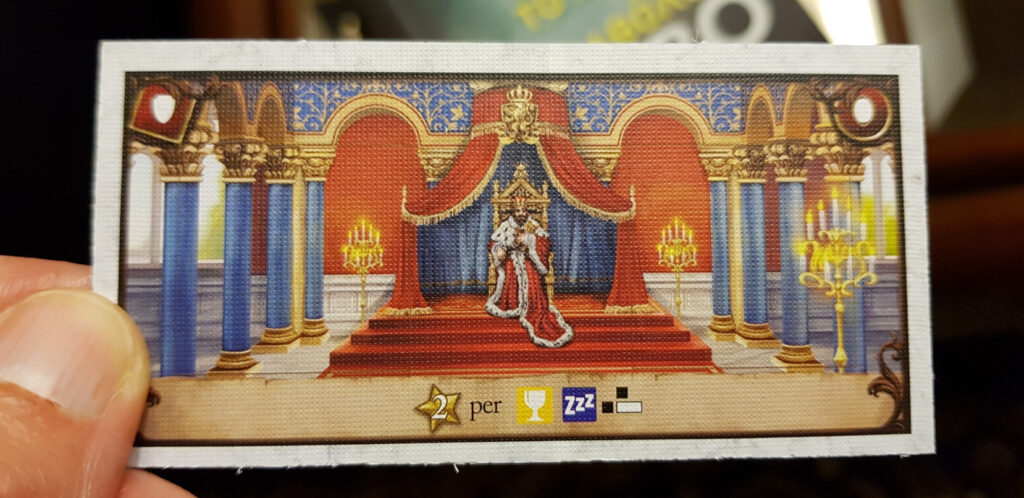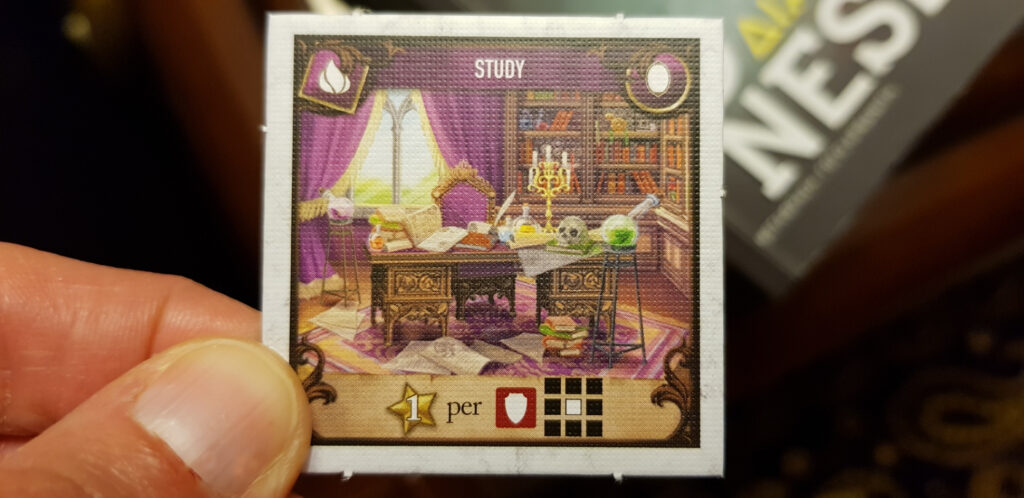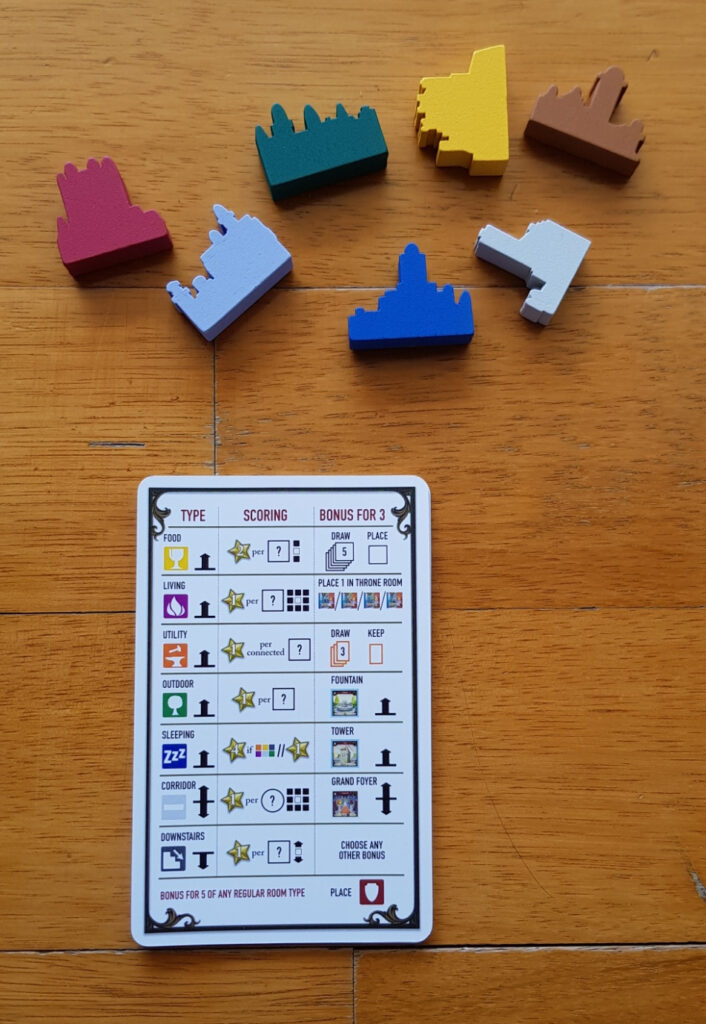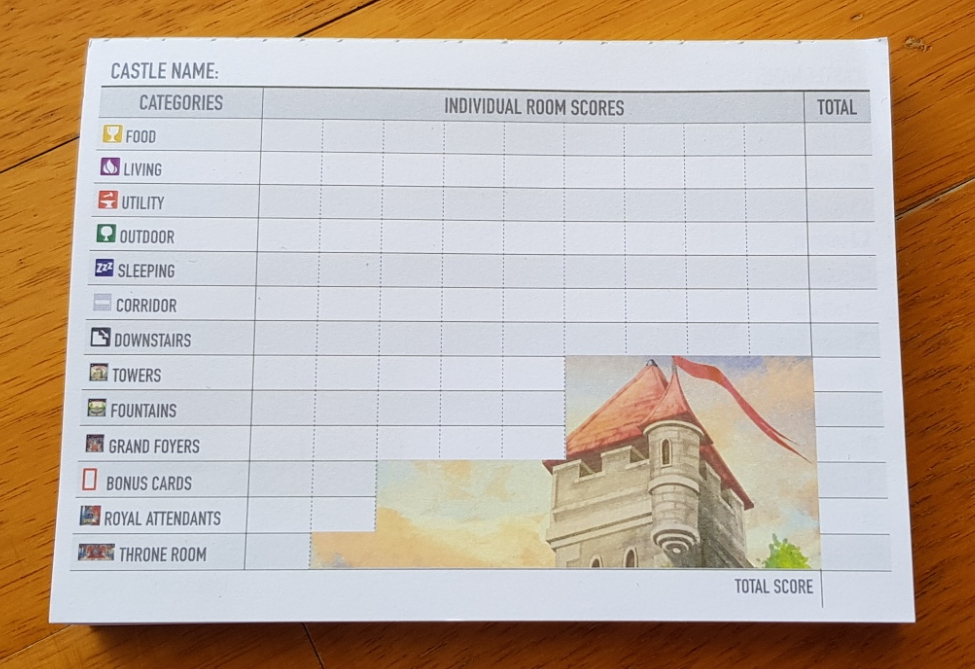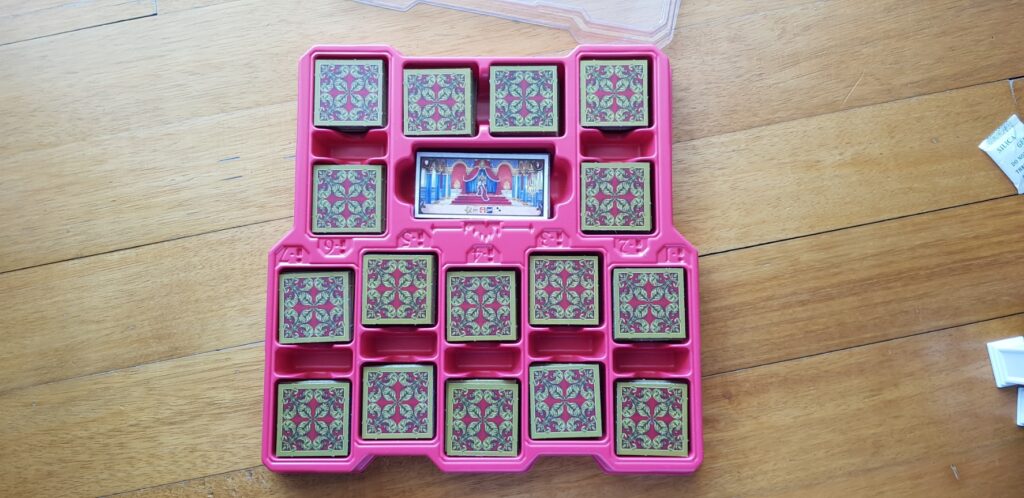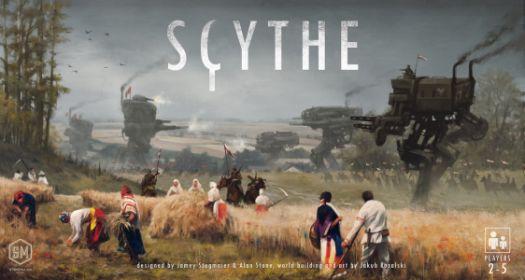Did I hear correctly? Castles? The Mad King? A drafting mechanic? Well, count me in, I need to hear no more. That was my initial response in hearing about Between Two Castles of Mad King Ludwig. But was my initial instict correct ? Well, that is why you are reading this review right now.
Castles of Mad King Ludwig and Between Two Cities are two separate games, published by Bezier Games (2014) and Stonemaier Games (2015) respectively. Between Two Castles of Mad King Ludwig is a game combining elements from both games, published by Stonemaier Games in 2018. It plays with three to seven (!) players, with a 2-player variant present, ages 10+.
In the game you take the part of a renowned master builder whom the Mad King Ludwig has asked for help in designing his castles. As you may know Ludwig II of Bavaria was accused as being mad partly due to his love for extravagant artistic and architectural projects but nowadays is considered as just a peculiar personality whose eccentricity led to some of the greatest and most impressive castles built in Europe. Back to our game, in order to execute your grandiose plans more successfully, you are paired with another master builder with which you will design and build each castle. In reality Between Two Castles of Mad King Ludwig is a tile-drafting game in which each tile is a room in a castle.
You work together with the player on your left to design one castle, and with the player on your right on another castle. On each turn you select two tiles from your hand, reveal them, then work with your partners to place one of your selected tiles into each of your two castles. At the end of the game, players calculate the score of each castle. Each person’s final score is the lower of the scores of the two castles you helped design, and the player with the highest final score wins the game. This win condition is a key element of the game that makes it a unique experience. It basically means that you have to divide your attention equally to both castles you are building.
At the start of the game, each player receives a player aids that contains everything they need to know about the game and places it in front of him/her. The throne room tiles are shuffled and one is placed between each pair of players. This is the heart of the castle which is built first and from which the castle will be expanded all ways.
The game consists of 2 rounds. Players at the start of the game, draw 9 tiles randomly and after choosing two to keep, they pass the rest to the player on their left. Then they choose where to built each tile they have kept, collaborating with their partner. This process continues until only one tile remains to choose from, it is discarded and another round begins. In the second round, players repeat everything albeit after choosing the tiles to keep, they pass the remaining to the player on their right. After round two is over, each castle is scored. Each player’s final score is the lowest of the scores of his two castles. The player with the highest final score wins.
There are seven different types of rooms you may built, namely: Food, living, utility, outdoor, sleeping, corridor and downstairs. Starting from a special tile, the Throne Room which is considered to be in the ground floor, you gradually add rooms in the castle, expanding it from the Throne Room outer and higher. There is no limit to how wide or how high a castle may be. You can also build rooms bellow ground (only Downstair rooms or Corridors). There are special rules for some room types, e.g Outdoor rooms can’t have another room above them, which makes perfect sense.
But what is the criteria for a good room placement? Well, each room type has certain conditions which when met, can score a number of points. For example, Food rooms have one room type that they want to be either directly above, below or to the left/right of them. The food room receives 2 points for each room it wants that is in the correct position. Living rooms have a particular type of room that they want to be surrounded by, and it scores 1 or 2 points for each of that room type that surrounds it. All seven unique room types, each have their own placing requirements in order to make the most out of them.
The Throne Room itself is a specialty tile and each one, of the seven included in the game, is different. Each one requires different room types in certain positions around it and is scores points at the end of the game if these conditions are met. The throne room is also the place where royal attendants are placed. These are special people that provide extra score points for certain wall hangings that are found in rooms throughout the castle.
Whenever the 3rd room of the same type is built in a castle, it automatically gets a bonus, different for each room type. Moreover when the 5th room of the same type is built in a castle, a specialty room tile is chosen between three (Grand Foyer, Fountain, Tower) and built in the castle rightaway.
Now let’s get to analyze the game using our usual scoring categories:
Components
When I hear the name “Stonemaier games” as a game’s publisher, one of the first things that comes to mind is superb, quality components, included in standard editions of all games. So, when opening the game’s box, expectations were high and I wasn’t disappointed. The game’s main components are the room tiles, 147 regular room and 48 specialty rooms and they look absolutely stunning. The level of detail in the pictures shown in each tile is unparalleled, each one drawn with beautiful colors and depicting a certain aspect of life in a castle.
Each tile includes the name of the room along with some symbols which contain all the information one needs in order to choose the right placement for it. On the upper left corner there is a symbol of the room type (which is also designated by the background color of the symbols and the card in general). On the upper right there is a symbol of a certain wall hanging that resides in the room (it can be a painting, mirror, torch or coat of arms). The type of wall hanging matters when scoring royal attendants at the end of the game. On the bottom of each room tile, the certain conditions that it requires to be met in order to be scored at the end the game, are presented in the form of symbols.
My only complaint about these tiles is that I would prefer them a bit larger in order for the symbols to be more readable. However I understand that this would have an impact on the game’s price and it would increase the space needed to play the game, which is rather large as is. The room tiles are made of very thick cardboard, very durable. Royal attendants are also made from the same material.
Other components of the game include 7 player aids, 20 bonus cards, 7 castle tokens and scoring sheets.
The player aids sum up everything you need to know about the game, the symbols for each room type, where each room type can be built, how it is scored and what bonus they provide. As this information is also included on the room tiles I found little use of these player aids.
The castle tokens depict different shapes and colors of castles and they intend to differentiate each castle from the other for scoring purposes. They are made of wood.
The bonus cards somehow lack the quality of the rest components but certainly fulfil their purpose.
The scoring sheets make scoring each castle an easy job and I am glad they were included.
Last but not least the most impressive component of the game, apart from the room tiles, are the exquisite trays that are used to store the tiles but also to keep them organized during play. They are beautiful and serve their purpose in the best possible way. Such a component is usually not provided in standard editions of games but are sold as extras, so once again thumbs up to Stonemaier games for the inclusion. All in all, components is definitely a big plus in this game. So, it’s 10/10.
Gameplay
Between Two Castles of Mad King Ludwig is all about choices. Choose which tiles to keep. Then choose where to build them. I actually like to have such absolute control in a game even if the final placement is the outcome of a collaboration with a partner. This social aspect of the game is wonderful. Players are not forced to make secret plans on their own and then try to execute them. There is constant talk between players (hopefully coming to an agreement about tile placement without quarrels) and that is something we rarely see in a game. Afterall, this kind of socializing is one of the reason we play board games: to communicate. An interesting fact about the game is that while playing, it seems a bit like a cooperative game, although each player actually is working for his own victory.
The rules of the game are pretty simple, and you don’t have to remember anything while playing. All information is presented on the tiles and on the player aids, so this is an ideal game for players who don’t like to fuss with complicated rules. However mastering the game is not that simple and certainly requires exercise. As does the ability to find a balance between your two castles and assuring that they will be as equally developed as possible. Because remember that your final score is the lowest of your two castles. Pretty tricky, ha?
The 2-player variant is pretty interesting as you each build one castle with your opponent and one with the Mad King himself! One player takes the role of Ludwig during the first round and the other on the second. I found that very intuitive and it actually works well. I found myself choosing to keep “bad” tiles for the castle my opponent was building with Ludwig but in the other round, my opponent could do that too, so balance was achieved. Of course the game shines when played with more than 3 players (actually the more the best) but it plays nicely even with two.
Playing time of the game is about 45 to 60 minutes. That is independent from the number of players because all players simultaneously choose the tiles to keep and they simultaneously build the rooms in their castle.
Overall I found this game a refreshing idea, masterfully executed, with game mechanics that work well, sharpen your mind and enhance fruitful collaboration. 8/10.
Learning Curve
A game very easy to learn. Everyone can learn the basics within minutes. Nothing really to remember, all information is presented on tiles and the player aids. 9/10
Theme
Due to the great illustrations on room tiles it certainly feels like building a castle. This feeling is enhanced by the fact that the building process is pretty realistic. For example, you can’t build above outdoor rooms. Moreover, every room above the ground level must be supported by a tile below. I also liked the presence of wall hangings as well as royal attendants. It certainly enhances immersion in the game.
The theme is also supported by the great variety in the different rooms you can build.
Finally, castles are always a unique creation which you can study at the end of the game, wishing it somehow was real and being built for you. 7/10
Replayability
Between Two Castles of Mad King Ludwig is a game I would always like to play again for the following reasons:
- You never get to build two identical castles Each castle is unique.
- I am more than eager to try finding nice combinations of tiles that may lead to a castle worth more points. Its easy rules make it accessible to all gaming groups from children to elder people and it provides an entertaining way of training your brain. 8/10
Fun
This is a game that one can certainly have fun with. That is accomplished by the collaboration with other players and by boggling your mind trying to find the best placement for your tiles. For me, that’s fun enough. 7/10
Final Verdict
In Between Two Castles of Mad King Ludwig you build fabulous castles for the Mad King Ludwig II of Bavaria. The game offers originality in its mechanics, theme and scoring and is aesthetically impecable. It features a tile-drafting mechanic as well as simultaneous action selection that minimizes downtime and results in a fast-paced game. The rules of the game are super easy but require you to concentrate in taking the best decisions. It hones your collaboration skills as you must cooperate with players on your left and on your right upon every tile placement. In the end of the game you will find yourself admiring your unique architectural wonder and crave for more.
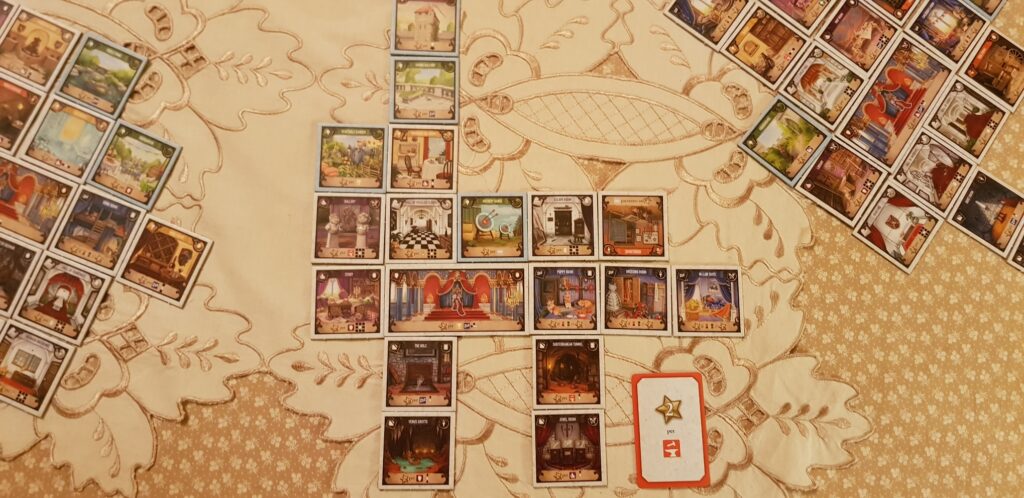
Recommended for: Strategy game lovers
According to our scoring system for board games, scoring categories have different weights. Components have 15% weight, Gameplay 35%, Learning curve 5%, Theme 5%, Replayability 25%, Fun 15%. According to this system and the above scoring in each category, overall weighted scoring of the game is:
Overall: 8.15

